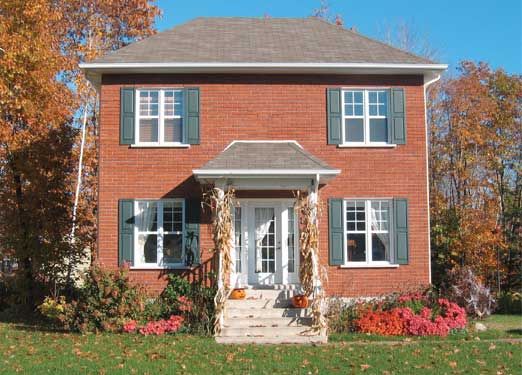
 by Jennifer Jones
by Jennifer Jones
Even though the vibrant colors of summer fade to an end, it does not mean that colorful plants are finished for the year. On the contrary, autumn is a season of the most magnificent colors of crimsons, oranges and yellows. As the leaves change to rich hues, many plants hit the peak of their blooming when the hottest weather of summer is over. Remarkable fall gardens are becoming increasingly popular among homeowners.
View Georgian House Plans
When planning a fall garden, you will want to begin preparation and planting in the springtime. The plants will need sufficient time to grow and properly generate blooms.
Many of these late blooming plants also look beautiful all through the summer and are drought tolerant, tough and can grow tall and dramatic. As the seasons progresses, remember to deadhead the flowers continually to encourage longer blooming time. Many gardeners will plan a variety of plants at several different sizes for plenty of texture to their fall garden.
There are a wide variety of perennials that produce incredible color for a fall garden. When purchasing new perennial plants, begin with one-gallon pots with lush foliage and have not begun blooming yet. As the years and season progress, perennials will produce more and more colorful flowers and foliage.
The following is a list of popular perennials for fall gardens:
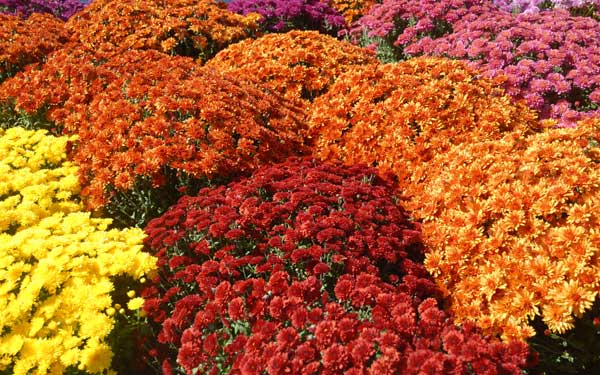
Chrysanthemums – Mums bloom in late summer into fall in response to the days growing shorter and the nights longer. They come in bold colors of yellow, orange, red, white and pink. There are several different types of mums including pompon, decorative, spider and the popular standard bush. As the years progress, mums can size up to as large as 36 inches wide and tall. They are quite spectacular in masses, and also work well for edgings and in containers.

Heather – Low maintenance and drought tolerant, heather plants boast colorful flowers that come in a variety of pink, white, amethyst, lavender, magenta, red and purple. They are low-growing plants that bloom from July to November. It has evergreen qualities and the foliage colors range from every shade of green to copper, gold and bronze. Since they supply foliage color throughout the colder months, they are popular for breaking up dreary winter landscapes.
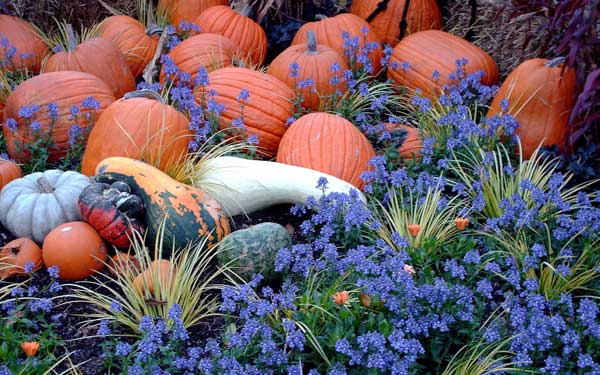
Leadwort – Otherwise known as plumbago, this groundcover perennial produces adorable little blue flowers later in the season and continue to bloom as its leaves turn a remarkable red-orange in autumn. Since the plant is late to emerge in spring, keep note of its location in order to avoid damage. Once it begins growing for the season, leadwort appears as a wiry and wood-like groundcover that can be somewhat invasive. Many gardeners with mix it with spring bulbs since its foliage emerges around the same time that the bulb flowers are dying back.

Aster – This hardy and robust plant produces clouds of daisy-like flowers in lovely pinks and purples. They can grow in compact 18 inch tall bunches and some varieties get up to 48 inches tall. They do best in full sun and are another good perennial to mix with spring bulbs since they can look a bit weedy. Many gardeners will prune them back in late June to encourage taller flower stalks come fall. Divide asters in spring to promote healthier and vigorous plants.
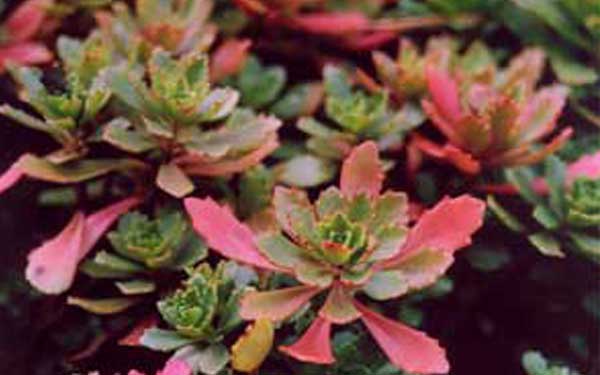
Sedum – Sedums are quite hardy to the cold and come in a wide array of shapes and sizes. Some varieties grow as small trails, while others grow upright and tall, and they can get up to two feet tall and wide. They have fleshy leaves and bloom in late summer and fall. Sedum produces large flower clusters in colors of purples, pinks and maroons.
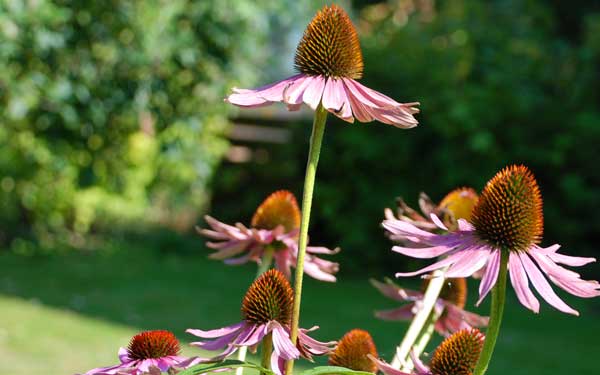
There are many more perennial plants that also are perfect for the fall season. Hostas produce gorgeous foliage all season and some varieties produce tall flower stalks. Many varieties of daylilies produce flowers all through the season into the fall. Coneflowers are tough perennials that bloom in glorious colors of white, orange, pink and red throughout July and August. Ivy makes an excellent ground and wall cover, as well as provides color throughout the winter months. Ornamental fountain grasses add plenty of interest to fall gardens. Salvia displays gorgeous purples and produces a lot of blooms throughout summer up until the first frost. Shasta daisies, coreopsis and goldenrods are also popular perennials that bloom all fall for plenty of beauty.
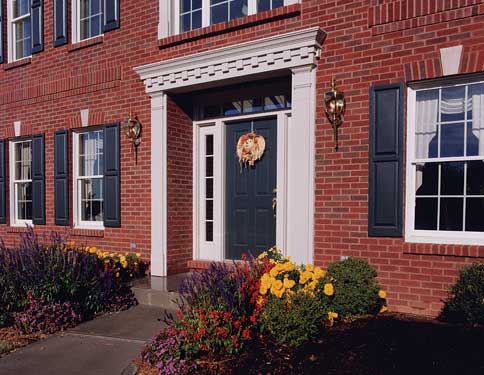
View This House Plan to the right
View Colonial House Plans
In addition to perennials, there are quite a few annual flowers that love the fall. Million Bells produce a bunch of tiny flowers all through their season. Zinnias are colorful and will bloom up until the first frost. Marigolds produce bright yellow-orange flowers and are excellent for keeping the bugs at bay. Moss verbena produces a fragrant smell, attracts butterflies and blooms in bright colors. Here are a few more popular annuals to plant for an excellent fall garden:
Sweet Alyssum – This flower produces small white clumps of flowers. It starts blooming mid summer and continues up to the first frost of the fall. Sweet alyssum spreads incredibly well and will drop seeds to reproduce for the following spring.

Cosmos – For a tall flower that is effort-free, cosmos is the perfect flower to choose. They have colorful blooms that appear around mid-summer until the first frost. Cosmos’ have delicate flowers that come in soft, pastel shades and attract birds, butterflies and bees. Drought-tolerant and sturdy, this annual loves the sun and are easy to grow.
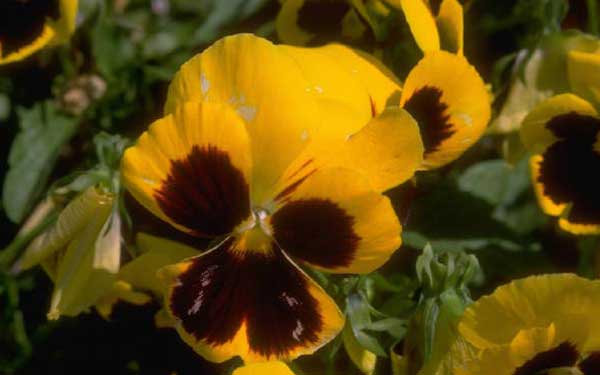
Pansies – Pansies are a great choice for flower beds, container, borders and other large groupings of autumn flowers. Their flowers bloom in a variety of color from purples and blues to yellows and oranges. They grow well in about any environment from full sun to part shade and many will continue to bloom through the winter, if the cold weather is mild enough.
Sunflowers – Many gardeners enjoy the happiness of sunflowers. Some species can grow up to 13 feet tall and need stakes to help keep them upright. Other varieties get up to 12 inches tall and form a bush. Their beautiful flowers are usually a bright yellow or oranges, but some bloom in rich colors of red and burgundy. Nonetheless, it is a breathtaking flower to include in a fall garden.
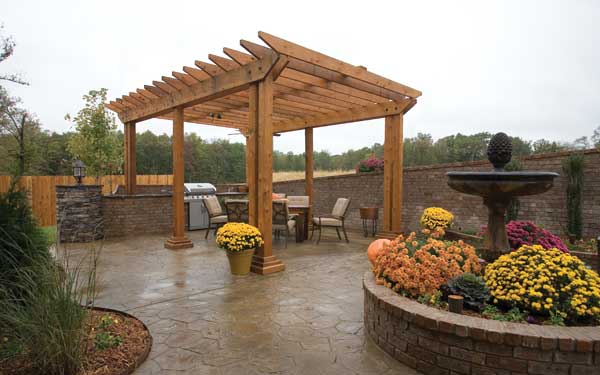
View This House Plan
View Craftsman House Plans
Once you have decided on flowers for you fall garden, take some time to plan out the positioning of the plants. Taller plants, like butterfly bush, ornamental grasses and sunflowers should go in the back of the garden. Daisies and coreopsis are perfect mid-size flowers for the middle on the garden. Sedum and other low-growing plants should be built around the borders and in the front. For a variety of texture and interest, leave the spent plants in your fall garden as well as the seeds on these plants. Many times they will reseed themselves and come back next spring all on their own. Try to include a mixture of foliage plants and flowering plants for plenty of attraction and appeal.
Gardening is a year-round hobby. With the some planning, even a beginner gardener can create an amazing garden that will produce beautiful colors for the fall. Although spring and summer displays of sunny flowers are brilliant, they do not compare to the boldness and rick colors of a majestic autumn garden.
Here are some related articles:
Save this article to:
back to top